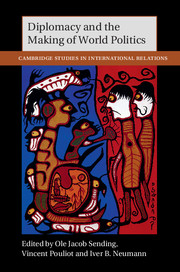Book contents
- Frontmatter
- Contents
- Contributors
- Acknowledgments
- Introduction
- Part I Making of international institutions
- Part II Making international cooperation
- Part III Diplomacy as a contested terrain
- Conclusion: Relationalism or why diplomats find international relations theory strange
- Bibliography
- Index
- Cambridge Studies in International Relations
Introduction
Published online by Cambridge University Press: 05 September 2015
- Frontmatter
- Contents
- Contributors
- Acknowledgments
- Introduction
- Part I Making of international institutions
- Part II Making international cooperation
- Part III Diplomacy as a contested terrain
- Conclusion: Relationalism or why diplomats find international relations theory strange
- Bibliography
- Index
- Cambridge Studies in International Relations
Summary
This book examines world politics through the lens of diplomatic practice. We argue that many global phenomena of our time, from international law to world order, through humanitarianism, global hierarchies, and public power, are made possible by evolving forms of diplomacy. In that sense, this book is not about diplomacy per se, but rather about the constitution of world politics in and through diplomatic practice. To shed new light on the making and remaking of international relations, we bring social theory to bear on diplomacy. Our starting point is simple: as we enter the twenty-first century, everybody seems to agree that diplomacy is changing, yet few people can specify exactly how – and with what effects on world politics. Our goal is to produce new knowledge about the evolving character of diplomacy and the ways in which it (re)constitutes significant facets of world politics.
In this Introduction, we accomplish two main goals. First, we provide theoretical tools to better grasp the role and character of diplomacy and how it may be changing in the contemporary era. We develop a relational framework focused on two dimensions: the evolving configurations of state and non-state actors and the competing authority claims that underpin diplomatic practices on the world stage. Second, we begin to theorize the ways in which diplomacy makes and remakes world politics. The remainder of the book offers rich case studies to empirically substantiate our broad argument about the constitution of world politics in practice. In this Introduction, our more limited objective is to explain the significance of our argument for key debates in international relations (IR).
All in all, by bringing theory to bear on diplomacy and, reciprocally, by bringing diplomacy back into the study of world politics, this book clears new grounds in IR. While diplomatic studies would greatly benefit from a more concerted effort at theorizing, the rest of the discipline should also pay careful attention to the larger effects of what is actually going on in the engine room of global politics. This Introduction supplies the building blocks for both of these contributions. But first, we make the case for a renewed effort at theorizing diplomacy.
- Type
- Chapter
- Information
- Diplomacy and the Making of World Politics , pp. 1 - 28Publisher: Cambridge University PressPrint publication year: 2015
- 17
- Cited by

